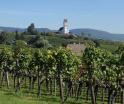Schaffhausen
The wine-growing canton of Schaffhausen has some 480 hectares of vines. The variety of Pinot Noir reigns supreme, covering almost 80 percent of the total surface. The region is dedicated to it because the conditions are ideal: calcareous, nutrient-rich soils and a mild, dry climate.
Hallau, the largest wine-growing town in German-speaking Switzerland, is in a way the capital of the country of the Pinot Noir of Schaffhausen or the “Blauburgunderland” in german.
The canton of Schaffhausen is divided into four wine-growing regions
Klettgau
The Klettgau is located in rural seclusion, shares a long border with Germany and is with 389 hectares of vineyards Schaffhausen's most important wine-growing region.The largest continuous vineyard in German-speaking Switzerland extends over gentle hills, all the way to the northern edge of Switzerland, from Gächlingen to Trassadingen, via Oberhallau and Hallau. The deep soils are made of calcareous clay and offer excellent conditions to the Pinot Noir or Blauburgunder.
Schaffhausen, Reiat und surroundings
At the end of the Middle Ages, the city of Schaffhausen was, thanks to its strategic location close to the Rhine Falls, the center of the wine-growing activities of Eastern Switzerland.
Today there are seven hectares of vineyards left that defy construction activity.
With the parcels located in Reiat, in the north-east of the canton, the vineyards of this area measure 28 hectares in total.
Stein am Rhein
In the upper part of the canton, the vineyards are located along the river Rhine, on the steep Wolkenstein hillsides between Stein am Rhein and Hemishofen. The acreage is 32 hectares.
The soils are, unlike those of Klettgau, shallow, sandy, gravelly and therefore lighter. They tend to produce more tender, but all the more fine wines.
Buchberg/Rüdlingen
The two wine-growing towns of Buchberg and Rüdlingen, entirely surrounded by Germany and the canton of Zurich, form an enclave south of the canton.Buchberg is the fifth largest wine-growing town in the canton.Together with the vineyards of Rüdlingen, the area counts 33 hectares. The soil consists of marl, sandstone and molasse. The Rhine, which calmly runs through this region, plays a regulating role by ensuring a mild and balanced climate. The wines produced in this region are particularly full bodied, rich and elegant.









